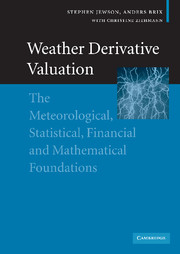 Weather Derivative Valuation
Weather Derivative Valuation Book contents
- Frontmatter
- Contents
- List of figures
- List of tables
- Acknowledgements
- 1 Weather derivatives and the weather derivatives market
- 2 Data cleaning and trends
- 3 The valuation of single contracts using burn analysis
- 4 The valuation of single contracts using index modelling
- 5 Further topics in the valuation of single contracts
- 6 The valuation of single contracts using daily modelling
- 7 Modelling portfolios
- 8 Managing portfolios
- 9 An introduction to meteorological forecasts
- 10 The use of meteorological forecasts in pricing
- 11 Arbitrage pricing models
- 12 Risk management
- 13 Modelling non-temperature data
- A Trend models
- B Parameter estimation
- C Goodness of fit tests
- D Expected pay-offs for normally distributed indices
- E Pay-off variances for normally distributed indices
- F Greeks for normally distributed indices
- G Exact solutions for the kernel density
- H The beta for a normally distributed index
- I Simulation methods
- J Efficient methods for pricing against a portfolio
- References
- Index
9 - An introduction to meteorological forecasts
Published online by Cambridge University Press: 22 September 2009
- Frontmatter
- Contents
- List of figures
- List of tables
- Acknowledgements
- 1 Weather derivatives and the weather derivatives market
- 2 Data cleaning and trends
- 3 The valuation of single contracts using burn analysis
- 4 The valuation of single contracts using index modelling
- 5 Further topics in the valuation of single contracts
- 6 The valuation of single contracts using daily modelling
- 7 Modelling portfolios
- 8 Managing portfolios
- 9 An introduction to meteorological forecasts
- 10 The use of meteorological forecasts in pricing
- 11 Arbitrage pricing models
- 12 Risk management
- 13 Modelling non-temperature data
- A Trend models
- B Parameter estimation
- C Goodness of fit tests
- D Expected pay-offs for normally distributed indices
- E Pay-off variances for normally distributed indices
- F Greeks for normally distributed indices
- G Exact solutions for the kernel density
- H The beta for a normally distributed index
- I Simulation methods
- J Efficient methods for pricing against a portfolio
- References
- Index
Summary
In this chapter and the next we will consider how weather forecasting and seasonal forecasting can potentially improve our valuation of weather derivative contracts. This chapter starts with a discussion of which weather forecasts are relevant to weather derivatives, and how these forecasts are made. We discuss forecasts of the expected temperature first, and forecasts of the whole distribution of future temperatures (probabilistic forecasts) after that. In each case we describe how to compare two forecasts to find out which is better, and briefly mention statistical methods with which one can try to improve forecasts. In the second part of this chapter we give a brief description of seasonal forecasts.
It is interesting to note that weather is somewhat different from financial market prices in the extent to which it is predictable. Forecasts of changes in financial market prices are possible, and may be successful, but there is a feedback between the forecast and the price, which means that, over time, all forecasting systems are likely to fail. Weather, on the other hand, is not affected by weather forecasts, and the dynamics of weather is constant. This allows forecast systems to be constructed that will continue to make useful predictions now and into the future. There is, however, a parallel between the unpredictability of changes in market prices and weather in that changes in expected weather are unpredictable.
- Type
- Chapter
- Information
- Weather Derivative ValuationThe Meteorological, Statistical, Financial and Mathematical Foundations, pp. 192 - 219Publisher: Cambridge University PressPrint publication year: 2005


